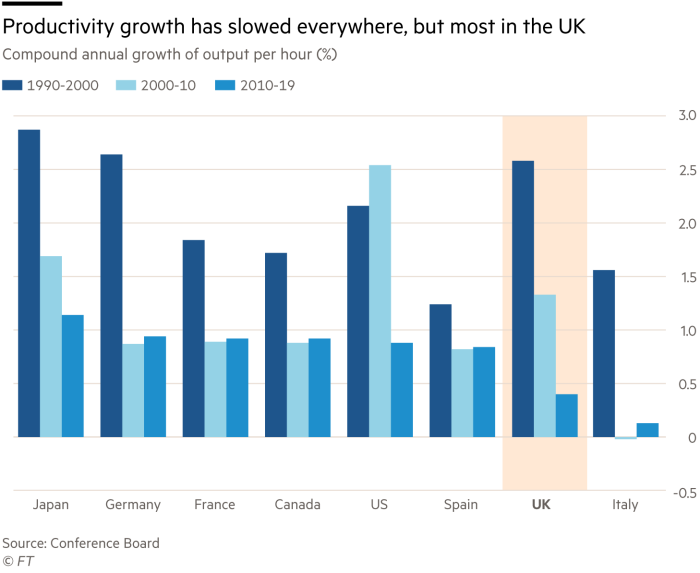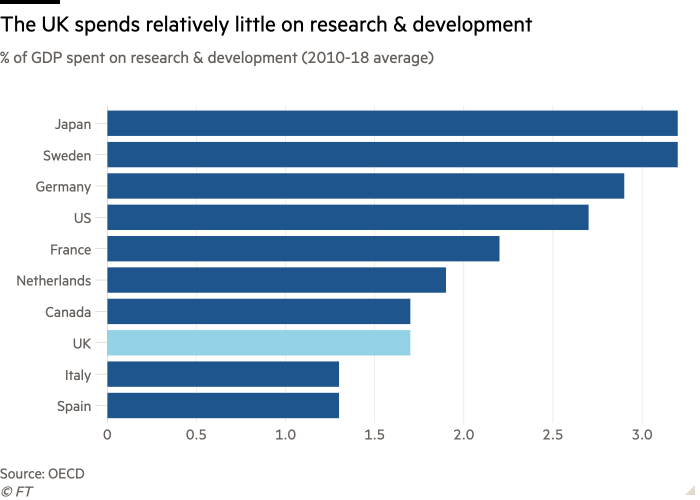Why once successful countries like the UK get left behind


Roula Khalaf, Editor of the FT, selects her favourite stories in this weekly newsletter.
Since the global financial crisis, UK productivity has been virtually stagnant. In a stagnant economy, economic policy becomes zero-sum: the situation of some can only be improved by worsening that of others. This is a recipe for conflict. It is essential to generate sustainable economic growth, instead.
The decline in productivity growth is not unique to the UK. Every member of the G7 leading high-income countries had sharply lower growth of output per hour between 2010 and 2019 than between 1990 and 2000. But the UK’s deterioration was the biggest, down from an annual rate of 2.6 per cent to a mere 0.4 per cent. The only G7 economy with lower productivity growth in the latter period was Italy.
Proximate explanations are easy to find: the UK’s average annual gross fixed investment was the lowest in the G7 between 2010 and 2018, at just over 16 per cent of gross domestic product; and the only G7 country with lower average investment in research and development was, again, Italy. Since new technology is embodied in new machinery, such low investment almost guarantees low productivity growth.

Why has UK growth slowed to a crawl? The best analysis I have seen of the determinants of growth is in Windows of Opportunity by David Sainsbury, a businessman who served as science minister in Tony Blair’s government. His views are rooted in those of earlier influential thinkers such as Alexander Hamilton and Joseph Schumpeter.
As Sainsbury states, neoclassical economics does not have a theory of growth, because it does not have a theory of innovation. He does: it is driven by innovative businesses. This he calls the “capability/market-opportunity dynamic”. There are four conditions for success: demand for new products and services; activity-specific technological opportunities; firms capable of exploiting those opportunities; and institutions able to support those firms.
Growth then is an evolutionary process characterised by trial and error, uncertainty, economies of scale and scope, network externalities, temporary monopolies and cumulative advantage. Historical experience confirms that growth is a race to the top. It means exploiting new opportunities that generate enduring advantages in high-productivity sectors and so high wages.

This perspective allows Sainsbury to consider why some countries have succeeded economically, why others have failed to do so and, not least, why once successful countries may fall behind. The answer to the last is that they have lost out in too many of the new high-innovation, high-productivity sectors.
If we look at the successful catch-up growth stories of the past two centuries, from Germany and the US to Japan, South Korea and China, it was never about their doing more of the same thing. It was about developing new things and even more about their capacity to develop new things. Once an economy has lost that ability, it starts to stagnate.
Sainsbury argues that there are four possible strategies towards innovation: leave it to the market; support the supply of relevant factors of production (science and skilled people); support key industries and technologies; and pick specific firms/technologies/products. He argues that governments should do the second and third, but not the last. That can be better left to bankers or venture capitalists. But governments can and must fund science and the development of scientific and other skills and should promote a few broad industries and technologies.

The economic rationale for supporting innovation is that knowledge is a semi-public good. This is not just a theoretical point. In practice, government support has played a central role in developing almost all of the fundamental technologies of the 20th and 21st centuries. But governments play a central role, more broadly, in developing all the capabilities Sainsbury discusses. This is because almost any significant new capability has public goods aspects. To take one example, the knowledge a business develops will be embedded in people who may leave to work for a rival business. Again, developing something fundamentally new is often both costly and risky. This, too, justifies some support.
The UK economy has an innovation — and so growth — crisis. Government must consider what to do about this. Why, for example, does UK business invest so little? Why does the UK have a relatively weak position in high-technology manufacturing? What industries and technologies offer the best opportunities for the future? How should university research be linked to business? The country is falling behind. These questions must be answered.
Follow Martin Wolf with myFT and on Twitter
Letters in response to this column:
Britain’s bonus culture is bad for productivity / From Andrew Smithers, London W8, UK
Comments